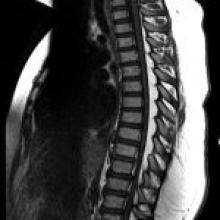June 6, 2019
A 9-year-old boy with a BMI of 40, worsening bilateral lower extremity weakness, and gait abnormality for three months. Preoperative physical exam shows bilateral lower extremity hyperreflexia, clonus, and positive Babinski. Four days postoperatively, he developed bilateral leg paralysis and a transient episode of hypotension.







